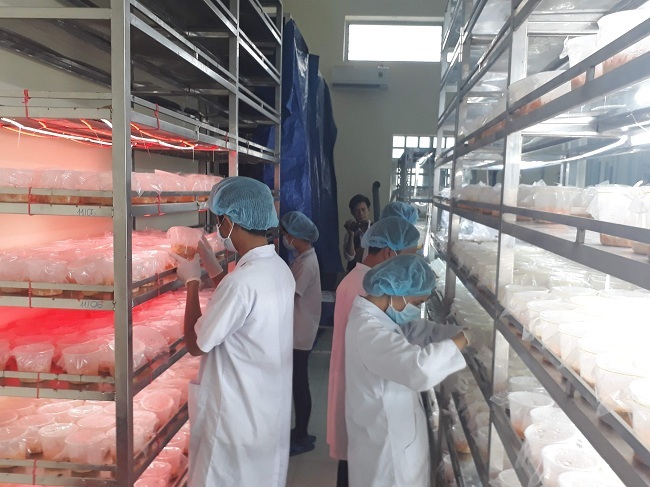Thu Dau Mot University set up a laboratory with modern equipment to cultivate cordyceps. In order to obtain cordyceps with highest quality, the scientists of the university attached importance to every stage of the cultivation process.

Breeders were imported from the American Type Culture Collection (ATCC), the US-based seed bank, the most respected in the world.
Cordyceps were cultivated in a sterile environment, in which all the requirements in temperature, humidity and light were strictly observed through the monitoring system which can be set up in automatic mode or control by smartphone.
|
Cordyceps were cultivated in a sterile environment, in which all the requirements in temperature, humidity and light were strictly observed through the monitoring system which can be set up in automatic mode or control by smartphone. |
“The cultivation environment was established to make it similar to the environment of cordyceps in nature,” Nguyen Thi Lien Thuong, director of Thu Dau Mot University’s Research & Experiment Center.
One of the most important factors in the cultivation and production process is cold heat extraction and vacuum condensation technologies. According to Thuong, industrial alcohol must not be used during the extraction process.
A molecular extraction chain was imported form South Korea to help create the finished products with high solubility and permeability.
Also according to Thuong, cordyceps must undergo experiments - biochemical, physicochemical and biomedical, and their quality must be assessed by indexes, not just color and appearance.
According to Dr Luong Le Hoang, cordyceps is effective for cardiovascular patients, post-cancer, trauma patients and those who have undergone surgeriy and suffer from chronic diseases.
“The medicinal herb helps to shorten recovery time, allows patients to come back to normal life soon. It is very useful for malnourished children and supplement therapy after dengue fever,” Hoang said.
Because of its wonderful uses, cordyceps are in high demand in Vietnam and many research works exist on how to cultivate cordyceps with high cordycepin concentration.
The value of cordyceps is heavily affected by the cultivation process. Different cultivation conditions will create cordyceps with different medicinal content.
One of the cultivation methods applied is the use of general chemicals. However, according to Nguyen Thi Ngoc Nhi from SAHA Company, substandard chemicals do not create high-quality products, and the chemical residue in products will make the product quality worse and dangerous to users.
Nhi and her co-workers have developed a cultivation process using materials in Vietnam, such as rice, sugarcane, sugar potatoes and silkworms, to create an environment for corcydeps development.
Tests show that the products created by SAHA have a concentration of cordyceps, the most important substance, at 8.69 mg per 100 grams of product. The cultivation process lasts 70 days which produces high-quality products at competitive prices.
RELATED NEWS
The ‘Tibet room’ full of cordyceps mushrooms in Hanoi
Cordyceps fungus successfully cultivated in Vietnam
Mai Lan
 Once the cultivation environment can be similar to the natural environment in which cordyceps grows, cordyceps of the best quality can be grown, scientists say.
Once the cultivation environment can be similar to the natural environment in which cordyceps grows, cordyceps of the best quality can be grown, scientists say.